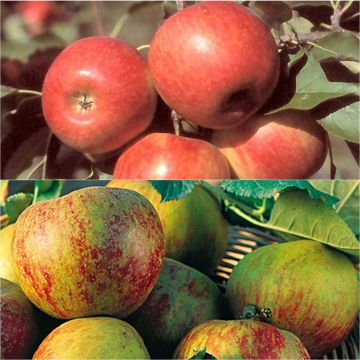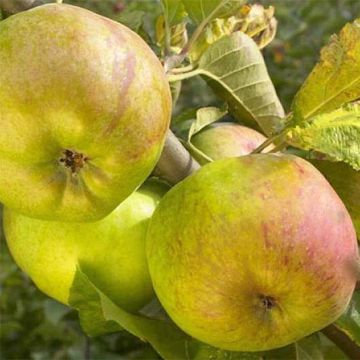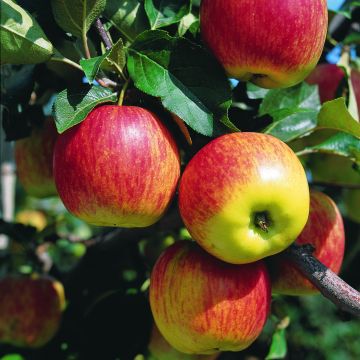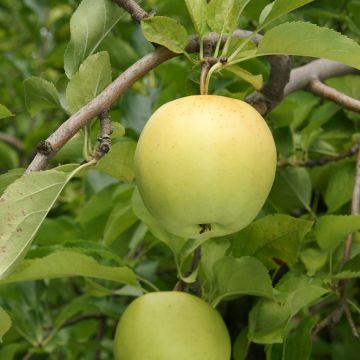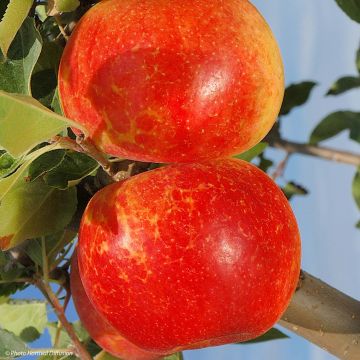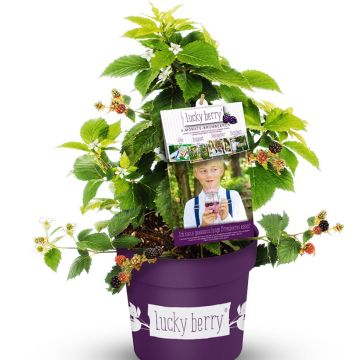

Pommier nain Fruit me Apple me Elstar


Pommier nain Fruit me Apple me Elstar


Pommier nain Fruit me Apple me Elstar
Dwarf Apple Tree Fruit Me Apple Me Elstar
Malus domestica Fruit Me Apple Me Elstar
Apple, Orchard apple, Table apple, Cultivated apple
Special offer!
Receive a €20 voucher for any order over €90 (excluding delivery costs, credit notes, and plastic-free options)!
1- Add your favorite plants to your cart.
2- Once you have reached €90, confirm your order (you can even choose the delivery date!).
3- As soon as your order is shipped, you will receive an email containing your voucher code, valid for 3 months (90 days).
Your voucher is unique and can only be used once, for any order with a minimum value of €20, excluding delivery costs.
Can be combined with other current offers, non-divisible and non-refundable.
Why not try an alternative variety in stock?
View all →This plant carries a 6 months recovery warranty
More information
We guarantee the quality of our plants for a full growing cycle, and will replace at our expense any plant that fails to recover under normal climatic and planting conditions.
Description
The Fruit Me Apple Me Elstar Apple Tree is an interesting fruit tree for its compact growth, perfectly suited for container cultivation. This does not prevent the plant from producing genuine Elstar apples, of the same size and value as those of a classic Elstar apple tree, and this from the first years of cultivation. A star among eating apples, this fruit is adorned with an attractive yellow skin striped with red, which protects a light yellow flesh that is both fine, crisp, sweet, and pleasantly refreshing. Not very self-fertile, it will be pollinated by the dwarf Fruit Me Apple me Yellow Golden apple tree.
The apple tree or Malus pumila var. domestica Fruit Me Apple Me Elstar is part of a series of semi-dwarf fruit trees that are quite revolutionary, recently developed in Spain. All the fruit trees in this range are grafted using a special technique onto a state-of-the-art rootstock that adapts to the available soil volume while allowing for quality fruiting from the first years of cultivation. The Fruit me range of fruit trees is also easy to grow, hardy, reliable, and less susceptible to diseases.
The 'Elstar' variety is the result of a cross between 'Golden Delicious' and 'Ingrid Marie' carried out in the Netherlands in 1955. It was named in 1972 and became popular among producers and the general public in the late 1970s. Its fruits, which ripen among the first, depending on the year and the regions, are harvested between early and mid-September. Highly aromatic, the fruits are pleasantly crisp and have a sweet and tangy flavour that is highly appreciated. Their yellow skin, striped and speckled with orange-red when fully ripe, is thin and digestible. Medium-sized and regular, it is a very good eating apple, which means it can be eaten raw without any preparation, but it is also delicious in compotes and jellies. The fruits can be stored for a good part of the winter.
In the ground, the Fruit Me Apple Me 'Elstar' Apple Tree develops a rounded, semi-upright habit with well-branched, airy growth and reaches a height of about 2.50 metres (8 feet) and a spread of 2 metres (7 feet) at maturity. In a pot, it will not exceed 1.50 metres (5 feet) in height and 80-90 cm (32-35in) in width. It is vigorous and resistant to cold. However, it is quite susceptible to common apple pests and diseases. It is a tree that produces large quantities of fruit. However, it may show a tendency to alternate bearing, meaning that a year of high productivity may be followed by a year of low harvest.
The flowering takes place in April, at the same time or a few days before 'Golden'. Thanks to its qualities as a pollinator, the Malus domestica Elstar helps to fruit other apple trees of different varieties in the vicinity. For its own fruiting, it requires the proximity of another pollinating apple tree variety such as Gala, Golden Delicious, Cox Orange, Reine des Reinettes, Granny Smith, Belchard, or Melrose. Indeed, like many apple trees, it is not very self-fertile.
The apple tree is a fruit tree belonging to the Rosaceae family. It is cultivated almost everywhere in the world and includes countless varieties, both old and modern, that produce apples of varying sizes and degrees of sweetness or tartness. They are native trees in Europe, where their presence has been documented since antiquity. Hardy, sometimes down to -30°C (-22°F) for the most resistant varieties, they can be grown throughout France.
The leaves of the apple tree are deciduous in winter and are arranged alternately on the branches. Their lamina is oval and toothed. They have a dark green upper surface and a whitish lower surface, slightly fuzzy. In spring, the apple tree bears white or pinkish-white flowers grouped in corymbs. The apple blossoms have 5 petals, and these white flowers surround a core composed of about 20 stamens. They give rise to fleshy, spherical fruits filled with seeds: apples. Their colour, size, flavour, and storage duration vary depending on the variety. Rarely self-fertile, the apple tree is a fruit tree that requires the presence of other apple trees flowering at the same time and in close proximity to bear fruit. The apples are harvested in late summer and autumn and, depending on the variety, can be stored for a long period in a cellar and consumed until early spring. Apples lend themselves to a wide range of culinary preparations (compotes, pies, jellies), but they can also be used to make apple juice or cider.
Report an error about the product description
Dwarf Apple Tree Fruit Me Apple Me Elstar in pictures






Plant habit
Fruit
Flowering
Foliage
Botanical data
Malus
domestica
Fruit Me Apple Me Elstar
Rosaceae
Apple, Orchard apple, Table apple, Cultivated apple
Cultivar or hybrid
Other Apple trees
View all →Planting and care
Choose a large pot or container (minimum 40 cm (16in) in diameter and 50 cm (20in) in depth) for your Apple Me® Elstar Apple Tree, and fill it with a mixture of potting soil and garden soil. Don't forget to place a layer of clay balls or gravel at the bottom of the pot to allow excess water to drain. Water regularly and apply fruit tree fertilizer in spring.
If planting in the ground, choose a sunny location with slightly alkaline or acidic soil, but without excess. Dig a wide planting hole at least 3 times the size of the root ball. Add organic matter (leaf compost...) and a slow-release fertilizer like bonemeal. Do not bury the graft. Stake if necessary. Water abundantly, even in winter, even if it rains. Fruit trees are ideally planted between October and March, avoiding frost periods. Container-grown plants can be planted year-round, except during periods of extreme heat or frost.
In winter, you can add a small handful of wood ash, rich in potash, to improve fruiting. Watch out for possible aphid attacks during the season. A white powdery fungus, powdery mildew, may appear on the leaves in summer, but it does not harm fruit development in gardens. Harvest takes place in September. Only keep harvested fruits. Store apples with the stem downwards, on shelves or in crates. Choose a preferably completely dark, dry and cool place, but frost-free.
Planting period
Intended location
Care
This item has not been reviewed yet - be the first to leave a review about it.
Similar products
Haven't found what you were looking for?
Hardiness is the lowest winter temperature a plant can endure without suffering serious damage or even dying. However, hardiness is affected by location (a sheltered area, such as a patio), protection (winter cover) and soil type (hardiness is improved by well-drained soil).

Photo Sharing Terms & Conditions
In order to encourage gardeners to interact and share their experiences, Promesse de fleurs offers various media enabling content to be uploaded onto its Site - in particular via the ‘Photo sharing’ module.
The User agrees to refrain from:
- Posting any content that is illegal, prejudicial, insulting, racist, inciteful to hatred, revisionist, contrary to public decency, that infringes on privacy or on the privacy rights of third parties, in particular the publicity rights of persons and goods, intellectual property rights, or the right to privacy.
- Submitting content on behalf of a third party;
- Impersonate the identity of a third party and/or publish any personal information about a third party;
In general, the User undertakes to refrain from any unethical behaviour.
All Content (in particular text, comments, files, images, photos, videos, creative works, etc.), which may be subject to property or intellectual property rights, image or other private rights, shall remain the property of the User, subject to the limited rights granted by the terms of the licence granted by Promesse de fleurs as stated below. Users are at liberty to publish or not to publish such Content on the Site, notably via the ‘Photo Sharing’ facility, and accept that this Content shall be made public and freely accessible, notably on the Internet.
Users further acknowledge, undertake to have ,and guarantee that they hold all necessary rights and permissions to publish such material on the Site, in particular with regard to the legislation in force pertaining to any privacy, property, intellectual property, image, or contractual rights, or rights of any other nature. By publishing such Content on the Site, Users acknowledge accepting full liability as publishers of the Content within the meaning of the law, and grant Promesse de fleurs, free of charge, an inclusive, worldwide licence for the said Content for the entire duration of its publication, including all reproduction, representation, up/downloading, displaying, performing, transmission, and storage rights.
Users also grant permission for their name to be linked to the Content and accept that this link may not always be made available.
By engaging in posting material, Users consent to their Content becoming automatically accessible on the Internet, in particular on other sites and/or blogs and/or web pages of the Promesse de fleurs site, including in particular social pages and the Promesse de fleurs catalogue.
Users may secure the removal of entrusted content free of charge by issuing a simple request via our contact form.
The flowering period indicated on our website applies to countries and regions located in USDA zone 8 (France, the United Kingdom, Ireland, the Netherlands, etc.)
It will vary according to where you live:
- In zones 9 to 10 (Italy, Spain, Greece, etc.), flowering will occur about 2 to 4 weeks earlier.
- In zones 6 to 7 (Germany, Poland, Slovenia, and lower mountainous regions), flowering will be delayed by 2 to 3 weeks.
- In zone 5 (Central Europe, Scandinavia), blooming will be delayed by 3 to 5 weeks.
In temperate climates, pruning of spring-flowering shrubs (forsythia, spireas, etc.) should be done just after flowering.
Pruning of summer-flowering shrubs (Indian Lilac, Perovskia, etc.) can be done in winter or spring.
In cold regions as well as with frost-sensitive plants, avoid pruning too early when severe frosts may still occur.
The planting period indicated on our website applies to countries and regions located in USDA zone 8 (France, United Kingdom, Ireland, Netherlands).
It will vary according to where you live:
- In Mediterranean zones (Marseille, Madrid, Milan, etc.), autumn and winter are the best planting periods.
- In continental zones (Strasbourg, Munich, Vienna, etc.), delay planting by 2 to 3 weeks in spring and bring it forward by 2 to 4 weeks in autumn.
- In mountainous regions (the Alps, Pyrenees, Carpathians, etc.), it is best to plant in late spring (May-June) or late summer (August-September).
The harvesting period indicated on our website applies to countries and regions in USDA zone 8 (France, England, Ireland, the Netherlands).
In colder areas (Scandinavia, Poland, Austria...) fruit and vegetable harvests are likely to be delayed by 3-4 weeks.
In warmer areas (Italy, Spain, Greece, etc.), harvesting will probably take place earlier, depending on weather conditions.
The sowing periods indicated on our website apply to countries and regions within USDA Zone 8 (France, UK, Ireland, Netherlands).
In colder areas (Scandinavia, Poland, Austria...), delay any outdoor sowing by 3-4 weeks, or sow under glass.
In warmer climes (Italy, Spain, Greece, etc.), bring outdoor sowing forward by a few weeks.



































